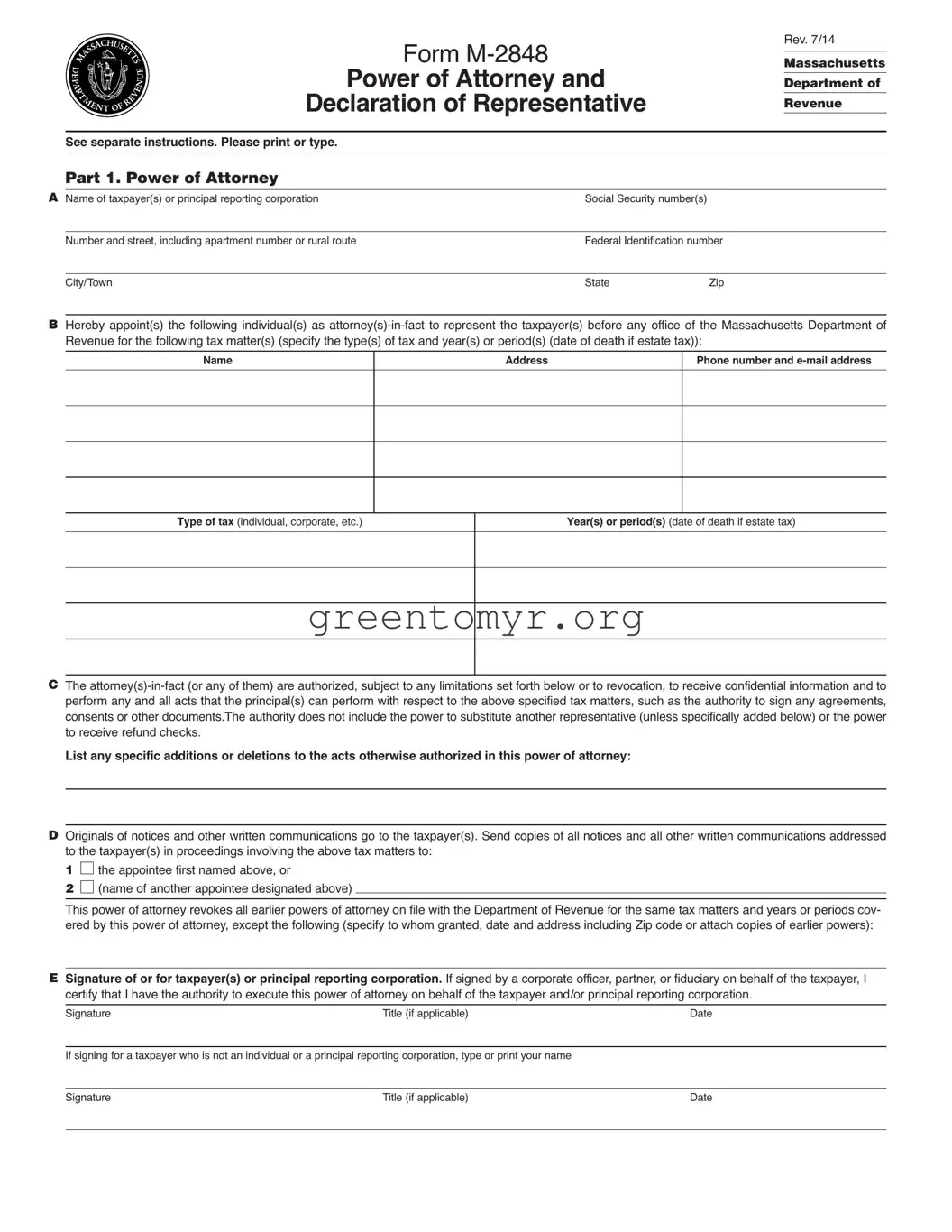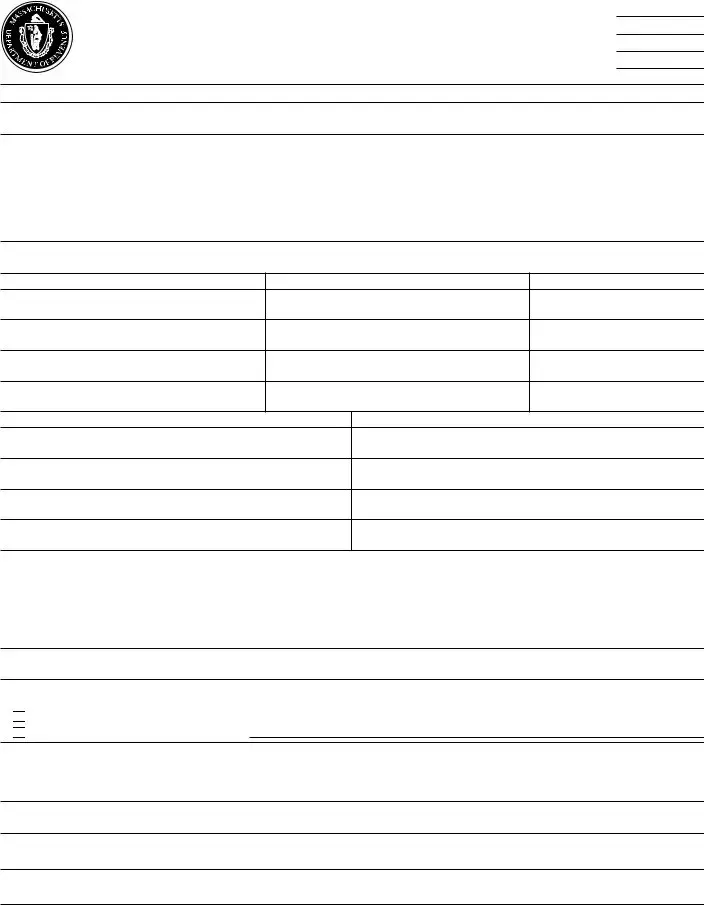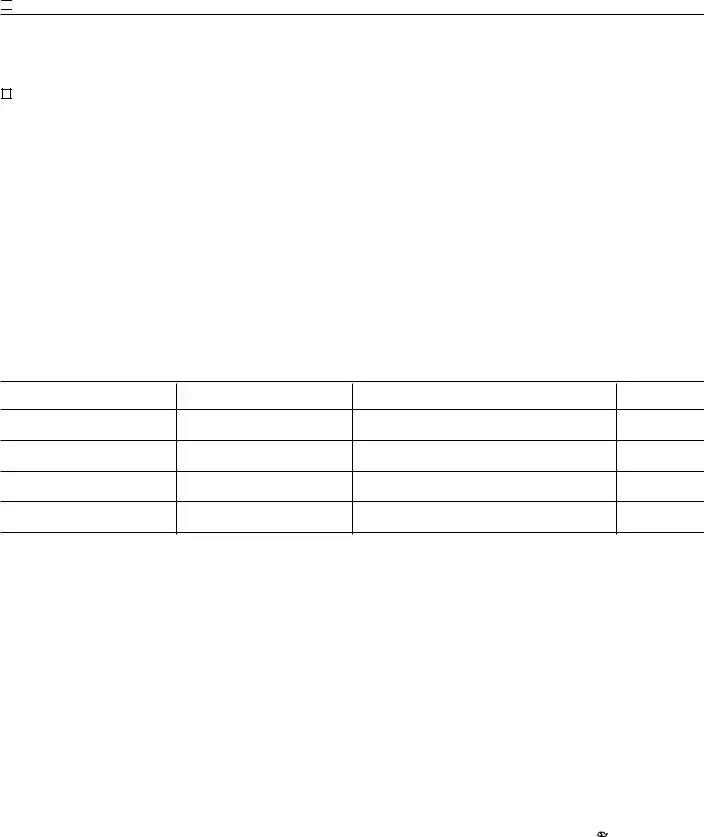General Information
To protect the confidentiality of tax records, Massachusetts law generally prohibits the Department of Revenue from disclosing information contained in tax returns or other documents filed with it to persons other than the tax- payer or the taxpayer’s representative. For your protection, the Department requires that you file a power of attorney before it will release tax information to your representative. The power of attorney will also allow your represen- tative to act on your behalf to the extent you indicate. Use Form M-2848, Power of Attorney and Declaration of Representative, for this purpose if you choose. You may file a power of attorney without using Form M-2848, but it must contain the same information as Form M-2848 would.
You may use Form M-2848 to appoint one or more individuals to represent you in tax matters before the Department of Revenue. You may use Form M-2848 for any matters affecting any tax imposed by the Commonwealth, and the power granted is limited to these tax matters.
For certain corporate excise matters under MGL ch 63. By executing this agreement an officer of a principal reporting corporation filing under MGL ch 63, § 32B represents that the principal reporting corporation is authorized to execute this agreement as agent for all corporations that par- ticipated in, or were required to participate in, such filing for any component of the corporate excise reported or required to be reported under any sec- tion of MGL ch 63 by any such corporation whether relating to the income measure, non-income measure, or a minimum excise tax liability under the corporate excise.
A principal reporting corporation acts on behalf of all corporations that partic- ipated in, or were required to participate in, a filing under MGL ch 63, § 32B, as stated in the preceding paragraph. Consequently, in the case of such a filing by a principal reporting corporation, the references in this agreement to “taxpayer(s)” shall include all such corporations.
Filing the Power of Attorney. You must file the original, a photocopy or facsimile transmission (fax) of the power of attorney with each DOR office in which your representative is to represent you. You do not have to file another copy with other DOR officers or counsel who later have the matter under consideration unless you are specifically asked to provide an addi- tional copy.
Revoking a Power of Attorney. If you previously filed a power of attorney and you want to revoke it, you may use Form M-2848 to change your rep- resentatives or alter the powers granted to them. File the form with the of- fice of DOR in which you filed the earlier power. The new power of attorney will revoke the earlier one for the same matters and tax periods unless you specifically state otherwise.
If you want to revoke a power of attorney without executing a new one, send a signed statement to each office of DOR in which you filed the earlier power of attorney you are now revoking. List in this statement the name and address of each representative whose authority is being revoked.
How to Complete Form M-2848
Part 1. Power of Attorney
A. Taxpayer’s name, identification number and address.
a.For individuals.Enter you name, social security number and address in the space provided. If joint returns involved, and you and your spouse are designating the same representative(s), also enter your spouse’s name and social security number and your spouse’s address (if different).
b.For a corporation, partnership or association.Enter the name, federal identification number and business address. If the Power of Attorney for a partnership will be used in a tax matter in which the name and social secu- rity number of each partner have not previously been sent to DOR, list the name and social security number of each partner in the available space at the end of the form or on an attached sheet.
c. For a principal reporting corporation. Enter the name, federal identifi- cation number and business address of the principal reporting corporation.
d. For a trust. Enter the name, title and address of the fiduciary, and the name and federal identification number of the trust.
e. For an estate. Enter the name, title and address of the decedent’s per- sonal representative, and the name and identification number of the estate. The identification number for an estate is the decedent’s social security number and includes the federal identification number if the estate has one.
B.Appointee(s) and tax matters and years or periods.Enter the name(s), address(es) and telephone number(s) of the individual(s) you appoint. Your representative must be an individual and may not be an organization, firm or partnership.
Consider each tax imposed by the Commonwealth for each tax period as a separate tax matter. In the columns provided, clearly identify the type(s) of tax(es) and the year(s) or period(s) for which the power is granted. You may list any number of years or periods and types of taxes on the same power of attorney. If the matter relates to estate tax, enter the date of the taxpayer’s death instead of the year or period.
If the power of attorney will be used in connection with a penalty that is not related to a particular tax type, such as personal income or corporate, enter the section of the General Laws which authorizes the penalty in the “type of tax” column.
C. Powers granted by Form M-2848. Your signature on Form M-2848 authorizes the individual(s) you designate (your representative or “attorney- in-fact”) generally to perform any act you can perform. This includes execu- ting waivers and offers of waivers of restrictions on assessment or collection of deficiences in taxes, and waivers of notice of disallowance of a claim for credit or refund. It also includes executing consents extending the legally al- lowed period for assessment or collection of taxes. The authority does not include the power to substitute another representative (unless specifically added to Form M-2848) or the power to receive refund checks.
If you do not want your representative to be able to perform any of these or other specific acts, or if you want to give your representative the power to delegate authority or substitute another representative, insert language ex- cluding or adding these acts in the blank space provided.
D. Where you want copies to be sent. The Department of Revenue rou- tinely sends originals of all notices to the taxpayer. You may also have copies of all notices and all other written communications sent to your rep- resentative. Please check box 1 if you want copies of all notices or all com- munications sent to the first appointee named at the top of the form. Check box 2 if you want copies sent to one of your other appointees. In this case, list the name of the appointee.
E. Signature of taxpayer(s). For individuals: If a joint return is involved and both spouses will be represented by the same individual(s), both must sign the power of attorney unless one authorizes the other (in writing) to sign for both. In that case, attach a copy of the authorization. However, if the spouses are to be represented by different individuals, each may execute a power of attorney.
For a partnership: All partners must sign unless one partner is authorized to act in the name of the partnership. A partner is authorized to act in the name of the partnership if under state law the partner has authority to bind the partnership.
For a corporation or association: An officer having authority to bind the en- tity must sign.
For a principal reporting corporation: An officer having authority to bind the principal reporting corporation of a combined group.



 the appointee first named above, or
the appointee first named above, or
 (name of another appointee designated above)
(name of another appointee designated above)

 is/are known to and signed in the presence of the two disinterested witnesses whose signatures appear here:
is/are known to and signed in the presence of the two disinterested witnesses whose signatures appear here: printed on recycled paper
printed on recycled paper